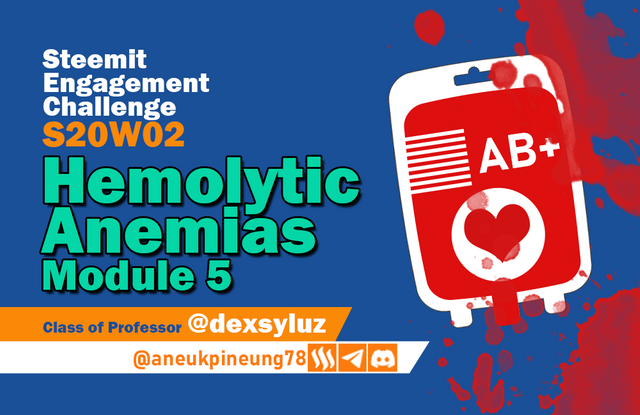This is my homework post for Steemit Engagement Challenge Season 20 Week 5 assignment of Professor @dexsyluz’s class, Hemolytic Anemias.

Task 1 - Define Hemolytic Anemias
- The Meaning of Hemolytic Anemias
Hemolytic Anemia comes from two words: 1) hemolytic and 2) anemia. Hemolytic means premature destruction of red blood cells. Anemia means lack of red blood cells (eritrosit). So, hemolytic anemia is a lack of red blood cells that occurs because red blood cells are destroyed prematurely. Normally, red blood cells live for and are produced in 120-day cycles. So when red blood cells are destroyed before they are 120 days old, there will be a deficit in red blood cell count because new cells have not been produced. - The Causes of Hemolytic Anemias
Based on the way a person gets the condition, it can be categorized into 2:- Hereditary. This type of hemolytic anemia is inherited from the parents and is usually due to a genetic mutation that causes disorders in red blood cells, especially their function and structure.
- Acquired. A person can suffer from hemolytic anemia due to infection or the influence of drugs, certain medical symptoms such as auto-immunity, and complications in incompatible blood transfusions.
- The Symptoms of Hemolytic Anemias
Basically, people with hemolytic anemia will have general symptoms of anemia and more specific symptoms.- Common symptoms of anemia:
- Fatigue. Reduced red blood cells mean less oxygen in the body's tissues, which makes the body feel tired and weak.
- Dizziness and even fainting. This is due to lack of oxygen in the brain.
- Pale skin. This is due to the lack of hemoglobon levels in the blood.
- Shortness of breath. Because the body is not getting enough oxygen.
- Specific symptoms of Hemolytic Anemia:
- Dark-colored urine. This is due to the presence of free hemoglobin or bilirubin that is released after the red blood cells are destroyed.
- Enlarged spleen or liver. The spleen and/or liver may enlarge due to the increased workload in destroying red blood cells.
- Abdominal or back pain. This may be caused by an enlarged spleen (splenomegaly) that is working hard to filter and destroy damaged red blood cells.
- The skin and eyes may become yellow, caused by elevated levels of bilirubin, a waste product of the breakdown of hemoglobin in red blood cells.
- Common symptoms of anemia:

Task 2 - Define Anemia Drepanocítica
- The Meaning of Anemia Drepanocítica
Linguistically, Anemia Drepanocítica comes from two words, namely 1) Anemia and 2) Drepanocítica. The meaning of anemia is already understood, while “drepanocítica” means “shaped like a sickle” (deprano is a Greek word meaning sickle), so Drepanocítica Anemia is also known as “Sickle Cell Anemia”. In theory, sickle cell anemia is a condition in which red blood cells change shape into a sickle shape after hemoglobin releases oxygen.
Sickle cell anemia starts with a genetic disorder that affects red blood cells, where the body produces an abnormal hemoglobin, called Hemoglobin S. As we have understood that hemoglobin is a protein in red blood cells that is responsible for transporting oxygen from the lungs to the rest of the body and bringing home the rest of the combustion process (CO2) to be disposed of through the respiratory system. The thing is, after releasing oxygen, the abnormal Hemoglobin S turns into a sickle-like shape, an abnormal shape for red blood cells, which makes them lose their elasticity and flexibility, become stiff, and break easily. Normally, red blood cells should be flat and flexible so that they can move easily within small blood vessels. - Specific symptoms of Anemia Drepanocítica
In addition to having general symptoms of anemia, specific symptoms of Anemia Drepanocítica include:- Fatigue, due to lack of oxygen in the muscles.
- Infection. The sickle cells can damage the spleen, an organ that helps fight infections.
- In children, swelling of the feet and hands is common.
- If this medical condition is suffered by children, it can cause growth retardation due to lack of oxygen and nutrients.
- Visual impairment, caused by the blockage of small blood vessels in the eye by sickle cells, can result in severe eye damage.
- Severe pain caused by the blockage of blood vessels by sickle cells, blocking blood flow to organs and tissues.

Task 3 - Intravascular Hemolysis vs. Extravascular Hemolysis
- Intravascular Hemolysis
- The Meaning of Intravascular Hemolysis
Intravascular hemolysis is hemolysis (destruction of red blood cells (erythrocytes)) that occurs within the blood vessels (intravascular). Normally, under normal conditions, red blood cells are 120 days old before they are destroyed in the spleen. In the condition of intravascular hemolysis, red blood cells are prematurely destroyed in the blood vessels, causing an increase in the level of free hemoglobin (without bound red blood cells) in the blood, called hemoglobinemia. The free hemoglobin is in turn filtered by the kidneys and results in hemoglobinuria (presence of hemoglobin in the urine). - The Causes of Intravascular Hemolysis
The causes of Intravascular Hemolysis can be grouped into:- Immunologic Causes, which are related to the immune system, can be caused by incompatible blood transfusions or medical symptoms such as auto-immune conditions.
- Infectious Causes, for example due to malaria (malaria parasites that live and multiply in red blood cells cause red blood cells to rupture as they go out to spread) and septicemia (damage to red blood cells due to toxins produced by bacterial infections and damage red blood cells directly in the blood).
- Toxic Causes, e.g. toxins from the bites of some types of snakes and insects.
- Medicinal Causes.
- Genetic Disease.
- And others.
- The Meaning of Intravascular Hemolysis
- Extravascular Hemolysis
- The Meaning of Extravascular Hemolysis
As the name implies, as opposed to Intravascular Hemolysis, Extravascular Hemolysis is the process of red blood cell (erythrocyte) destruction that occurs outside of blood vessels, usually within reticuloendothelial organs such as the spleen, liver, and bone marrow. In this condition, damaged and deformed red blood cells that are not destroyed in the blood vessels and make it to the spleen and liver or bone marrow are destroyed by macrophages (white blood cells that engulf foreign particles) in these organs. This means that when the damaged red blood cells survive the blood vessels, they are awaited by macrophages in the liver, spleen and bone marrow. - The Causes of Extravascular Hemolysis
- Reaction to a mismatched blood transfusion, where antibodies may mark the donor's red blood cells as foreign, and macrophages in the spleen or liver will destroy them.
- Enzyme abnormalities that may be caused by exposure to certain drugs or infections.
- Infection, for example due to malaria.
- Hemoglobin abnormalities, such as in the conditions Anemia Drepanocítica (Sickle Cell Anemia) and Thalassemia (a genetic disorder that causes abnormal hemoglobin production, resulting in red blood cells that are fragile and easily destroyed by the spleen).
- And others.
- The Meaning of Extravascular Hemolysis

Task 4 - Explain a Case of Hemolytic Anemia
- Background.
A man (30s) complained of severe fatigue and shortness of breath, and dark urine. These symptoms appeared gradually over several weeks. He also reported to the paramedics that he had been suffering from mild fever for the past few days. - A physical examination was performed and found:
- his skin and sclera (whites of the eyes) showed jaundice, indicating an increase in bilirubin in the blood;
- on palpation of the abdomen, the spleen was found to be enlarged, indicating that the spleen has been working too hard to destroy red blood cells.
- Following laboratory examinations, 3 tests were performed:
- Complete Blood Count (CBC), found:
- Low hemoglobin (8 g/dL, normal 12-16 g/dL);
- Red blood cell count decreased;
- Reticulocyte (newly-produced red blood cell, still in an early stage of development, not yet fully mature) count increased, indicating an attempt by the bone marrow to replace the lost red blood cells;
- Bilirubin test, finding:
- Indirect bilirubin is elevated, a sign of hemolysis;
- Direct Antiglobulin Test (DAT), finds:
- A positive result indicating that the patient's body is producing antibodies that attack their own red blood cells.
- Complete Blood Count (CBC), found:
- Diagnosis: The patient was diagnosed with Autoimmune Hemolytic Anemia (AIHA), a condition in which there is a lack of red blood cells because his immune system produces antibodies that attack and destroy his own red blood cells.
- Treatment
- Patients will be given Corticosteroid (Prednisone) drug therapy which is intended to suppress the immune system so that antibodies that attack red blood cells stop being produced;
- While waiting for the corticosteroid to take effect, a blood transfusion is required;
- If corticosteroids do not have an effect, other drug therapy such as rituximab is needed.
- Now we hope (and maybe pray) for the best.

Thanks
Thanks Professor @dexsyluz for the lesson. Inviting @rayfa, @ashkhan, @pea07
Sources and Reading Suggestions
- https://www.nhlbi.nih.gov/health/anemia/hemolytic-anemia
- https://www.hopkinsmedicine.org/health/conditions-and-diseases/hemolytic-anemia
- https://my.clevelandclinic.org/health/diseases/22479-hemolytic-anemia
- https://www.mayoclinic.org/diseases-conditions/sickle-cell-anemia/symptoms-causes/syc-20355876
- https://www.nhlbi.nih.gov/health/sickle-cell-disease
- https://en.wikipedia.org/wiki/Intravascular_hemolysis
- https://www.sciencedirect.com/topics/nursing-and-health-professions/intravascular-hemolysis
- https://www.sciencedirect.com/topics/medicine-and-dentistry/intravascular-hemolysis
- https://ilovepathology.com/hemolytic-anemia-extravascular-vs-intravascular-hemolysis-classification/
- https://www.sketchy.com/medical-lessons/extravascular-hemolysis-overview-rbc-membrane-defects
- https://www.ncbi.nlm.nih.gov/pmc/articles/PMC3167962/
- https://www.ncbi.nlm.nih.gov/books/NBK558904/
- https://scholar.ui.ac.id/en/publications/oral-manifestations-of-hemolytic-anemia-a-case-report




https://x.com/aneukpineung78/status/1844806178053714192
Downvoting a post can decrease pending rewards and make it less visible. Common reasons:
Submit
Dunia kesehatan merupakan dunia yang umum orang pelajari karena banyak masyarakat yang ingin mengetahui tentang kesehatannya. Dan ini menjadi referensi bagi pembaca terutama yang mengalami masalah dengan anemia.
Downvoting a post can decrease pending rewards and make it less visible. Common reasons:
Submit
This is my second article in the Hematology class run by Professor @dexsyluz , my first participation was in the 2nd week. I regret not having time to attend all the classes, because from the two classes I attended, I feel like I gained a little more knowledge about health, especially hematology and more specifically anemia. It is interesting how this class focuses directly on the topic of anemia so that the discussion is centered on that alone, although sometimes we need to refer to more general medical terminations.
Thank you, Chief for commenting and support. Getting comments from health practitioners for health articles is fun, but that doesn't mean that comments on non-health articles are less valuable. Haha.
Downvoting a post can decrease pending rewards and make it less visible. Common reasons:
Submit
Hahaha...
Saya dengan senang hati membaca artikel atau konten yang berkualitas dan meninggalkan jejak di sana seperti voting dan komentar..
Downvoting a post can decrease pending rewards and make it less visible. Common reasons:
Submit
You Posted on a very important topic. Your analysis and explanation about hemolytic anemias will be helpful to many. So good luck for the contest.
Downvoting a post can decrease pending rewards and make it less visible. Common reasons:
Submit
To my opininon, Season 20 has been the best season in SEC I have ever involved in. I hope some classes will continue in the seasons to come. What class do you like the most, @max-pro?
Downvoting a post can decrease pending rewards and make it less visible. Common reasons:
Submit